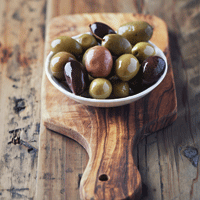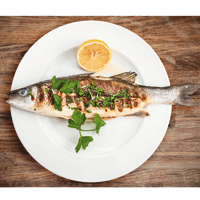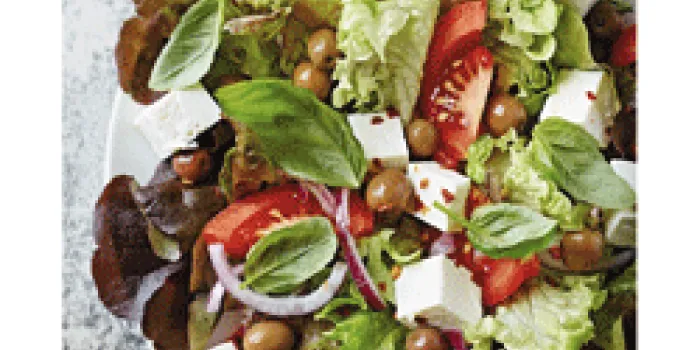In millions of American households, “Beef: It’s what’s for dinner” is not only a slogan, but also a staple. But those who sport the carnivore badge proudly need to rethink the foods that make them salivate. No longer is red meat the prince of the plate. It’s been relegated to a corner, outnumbered by a variety of colorful items from the crisper drawer.
“The Mediterranean diet is predominantly fruits and vegetables, whole grains, fish and much smaller amounts of meat,” says Tina Willis, MA, RD, CD, registered dietitian at the Indiana Hemophilia & Thrombosis Center in Indianapolis. “It also includes a lot of monounsaturated fats, such as olives and olive oil.” Nutritionists, dietitians, doctors and researchers say the science speaks for itself when the Mediterranean diet goes head to head with our meat-and-potatoes repast. The plant-based diet, with its emphasis on nutrient-rich foods that are high in fiber, low in saturated fats and high in antioxidants, has been shown to decrease inflammation, lower blood pressure and moderate blood sugar. It has been endorsed by the American Heart Association, Arthritis Foundation and American Diabetes Association.
Before giving your kitchen a Mediterranean makeover, it’s important to understand which foods help or hurt your health. Talk to your hematologist to make sure any foods or supplements you plan to include are safe for someone with a bleeding disorder. Then you can take steps to eat fewer of the troublemakers and add some of the superstars to your menu.
Rx for Inflammation

barol16/Thinkstock
People with bleeding disorders are familiar with inflammation; a raised bruise and puffy, swollen joints are examples. Inflammation is more widespread than that, though, say experts. “It can contribute to heart disease, strokes, certain cancers, even some dementia,” Willis says. “Almost any illness has some of its basis in inflammation.”
Cyclo-oxygenase-1 (COX-1) and cyclo-oxygenase-2 (COX-2) are enzymes in the body that worsen inflammation and increase your sensitivity to pain. Free radicals, unstable molecules that can cause cell damage, also are involved. “Free radicals cause inflammation, aging and are thought to contribute to our risk for different diseases,” says Willis. COX-1 and COX-2 inhibitors and flavonoids, phytonutrients in plants that act as antioxidants that neutralize free radicals, are found in abundance in many Mediterranean diet foods.
Seafood’s Net Worth
People who live near the Mediterranean Sea, such as Greeks, eat fish frequently, and so should we. That’s because certain cold-water fish, such as anchovies, herring, salmon, sardines, scallops and tuna, contain omega-3 fatty acids. Omega-3s help lower C-reactive protein (CRP), which is produced by the liver in response to inflammation in the body. Increased levels of CRP in the blood are associated with diabetes, heart disease and high blood pressure.
Although omega-3s can increase your risk for prolonged bleeding, it’s the supplements containing them that people with bleeding disorders should avoid, says Willis. “Unless someone is eating a really substantial amount of salmon every single day, it’s never been an issue.” The American Heart Association recommends eating 3 ounces of fish (about the size of a deck of cards) two to three times weekly.

Maksim Toome/Thinkstock
How you cook fish is just as important as choosing what types you buy. “If you fry fish, that’s considered negating the health benefits,” Willis says. The breading and extra oil add calories, fat and cholesterol. Grilling, broiling and baking are healthier cooking methods.
Fruits’ and Veggies’ True Colors
Orange juice at breakfast, an apple at lunch and a salad for dinner are a start toward the recommended nine or more servings of fruits and veggies daily. Remember: Darker is better. “The deeper the color, the more nutrients that are in that food,” says Willis. “Try eating the colors of the rainbow.” Fill your grocery cart with carrots, squash, broccoli, eggplant, tomatoes, onions and peppers.
In 2004, researchers from the US Department of Agriculture (USDA) analyzed the antioxidant values for more than 100 foods, publishing their results in the Journal of Agricultural and Food Chemistry. Surprisingly, beans held three of the top four places. Wild blueberries came in second. Cranberries and blackberries also scored highly. And steamed artichokes came in at number 7.
Often the main ingredient in chili and minestrone, beans are not only a good source of fiber and protein, but they also decrease inflammation, which can help lower CRP in the blood. They contain folic acid, which is good for the heart. Beans are filling and are slower to digest, keeping blood sugar levels moderated.
Garlic and onions contain allicin, which helps the body fight diseases caused by bacteria, fungi and viruses. Garlic can also lower cholesterol levels and high blood pressure.
Oils, Nuts and Nutty Oils
Not all cooking oils are created equal. “Saturated and trans fats can promote atherogenesis [plaque buildup on artery walls], so you want to consume less of those,” Willis says. Clogged arteries can lead to heart disease.
On the other hand, extra-virgin olive oil contains monounsaturated fat, which is healthier. This popular oil used for Greek cooking, for drizzling over salads and cooked vegetables, and for dunking pita bread was the subject of a study published in Nature in 2005. Researchers discovered that olive oil contains oleocanthal, a compound that works similarly to ibuprofen, inhibiting COX-1 and COX-2 enzymes and reducing inflammation. A 2013 study, published in the New England Journal of Medicine, followed nearly 7,500 people in Spain who were at risk for heart disease. At the end of five years, those on the Mediterranean diet who had added extra-virgin olive oil to their daily diet experienced significantly fewer heart attacks, strokes and deaths from cardiovascular disease than the other two groups.
“Up to 30% of your calories should come from monounsaturated and polyunsaturated fats, the good fats,” Willis says. Other sources include walnut and sesame seed oils, avocados and nuts. Pecans placed 14th in antioxidant content in the 2004 USDA study, way ahead of almonds and walnuts, which get more publicity. All contain vitamin B6. “But eat them in moderation, because they’re high in calories,” says Willis. An ounce a day, about ¼ cup, is all you need, she says.
Amber Waves of Whole Grains
In 2010, the USDA kicked off its MyPlate campaign, which is based on the Mediterranean diet. If you divide your plate into segments, half should contain fruits and veggies, and the other half should hold grains and protein. “Make half your grains whole” is one of the USDA tips. Whole grains include the bran and germ, the parts of the kernel that contain vitamins and minerals. They can reduce the CRP levels in your bloodstream. Good sources include oatmeal, barley, brown rice, couscous and polenta. Quinoa, buckwheat and soybeans are notable for providing all eight amino acids, making them complete proteins.
Minimizing Red Meat
Red meat, like ground beef and steak, does pack a lot of protein, but it also causes inflammation. So do processed meats, such as sausage and bacon, which are high in fat. That doesn’t mean you have to give up your burgers or brats; just limit the size and number of times you eat them. Willis recommends eating red meat a maximum of two to three times weekly. The Mediterranean diet goes even further. It places red meat at the top of its food pyramid, restricting its consumption to monthly. “The serving size is 2–3 ounces—very tiny,” Willis says.
If you’re craving meat, choose chicken or turkey instead. And be aware that there are red meats other than beef. “Currently, pork and lamb are considered red meat,” warns Willis.
Dairy Details
With Greek yogurt all the craze, it should be easy to find a fat-free yogurt with plenty of calcium. Skim milk and low-fat cheeses, such as feta or mozzarella, are also good choices. But watch the portion size. Four one-inch cubes of cheese make one serving.
Healthy Snacking
Crackers and chips are processed foods that typically have saturated or trans fats and salt. So if you need a mid-afternoon snack, try teaming a healthy bean spread, like hummus with tahini (sesame seed paste), with a high-fiber cracker, says Willis. “The chickpeas in the hummus have a lot of nutrients and fiber, with some good fat and protein.” But they’re high in calories, so avoid double dipping.
“Popcorn is very high in fiber, so it’s a really good snack,” Willis adds. But hold the butter and salt. Alternate between fruits and vegetables when you snack, says Willis. That way you won’t get bored, and your body will get a variety of nutrients.
Sugars and Sweets Are Limited Treats
Those delectable sweets in the bakery window hold a very small place in the Mediterranean diet. Pies, cakes, cookies and doughnuts are high in calories and low in nutrition, says Willis. “The simple sugars they contain are not good for us—they can increase inflammation.” Instead, try having a baked apple or pear, sprinkled with cinnamon and cloves, which have antioxidants. But if you simply can’t resist temptation, give yourself a sweet treat weekly or monthly.
Dark chocolate is a heart-healthy choice. It contains cocoa polyphenols that have been shown in clinical studies to reduce blood pressure and improve cholesterol levels. It also has antioxidants. Try to choose a bar with at least 60% cocoa.
But the Mediterranean diet is more than a menu plan; it’s also a way of life. Two other components are daily exercise and eating family meals together in a relaxed setting.
So whether you’re dieting or just improving your diet, small changes can lead to bigger health benefits when it comes to a Mediterranean makeover. “People feel a sense of accomplishment,” Willis says. “They end up surpassing what they thought they could do.”

